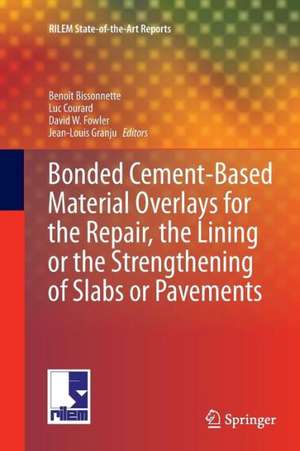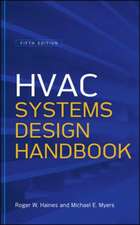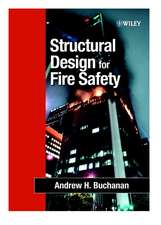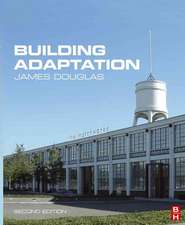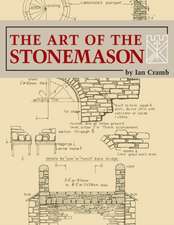Bonded Cement-Based Material Overlays for the Repair, the Lining or the Strengthening of Slabs or Pavements: State-of-the-Art Report of the RILEM Technical Committee 193-RLS: RILEM State-of-the-Art Reports, cartea 3
Editat de Benoît Bissonnette, Luc Courard, David W. Fowler, Jean-Louis Granjuen Limba Engleză Paperback – 21 apr 2013
| Toate formatele și edițiile | Preț | Express |
|---|---|---|
| Paperback (1) | 635.65 lei 6-8 săpt. | |
| SPRINGER NETHERLANDS – 21 apr 2013 | 635.65 lei 6-8 săpt. | |
| Hardback (1) | 642.51 lei 6-8 săpt. | |
| SPRINGER NETHERLANDS – 28 mar 2011 | 642.51 lei 6-8 săpt. |
Din seria RILEM State-of-the-Art Reports
- 15%
 Preț: 643.84 lei
Preț: 643.84 lei - 15%
 Preț: 659.20 lei
Preț: 659.20 lei - 15%
 Preț: 644.18 lei
Preț: 644.18 lei - 15%
 Preț: 637.59 lei
Preț: 637.59 lei - 18%
 Preț: 726.34 lei
Preț: 726.34 lei - 18%
 Preț: 947.50 lei
Preț: 947.50 lei - 20%
 Preț: 565.31 lei
Preț: 565.31 lei - 18%
 Preț: 788.54 lei
Preț: 788.54 lei - 18%
 Preț: 884.22 lei
Preț: 884.22 lei - 18%
 Preț: 953.65 lei
Preț: 953.65 lei - 18%
 Preț: 967.08 lei
Preț: 967.08 lei - 15%
 Preț: 640.06 lei
Preț: 640.06 lei - 15%
 Preț: 631.07 lei
Preț: 631.07 lei - 18%
 Preț: 1227.99 lei
Preț: 1227.99 lei - 15%
 Preț: 644.95 lei
Preț: 644.95 lei - 15%
 Preț: 640.24 lei
Preț: 640.24 lei - 15%
 Preț: 637.46 lei
Preț: 637.46 lei - 20%
 Preț: 589.83 lei
Preț: 589.83 lei - 15%
 Preț: 634.68 lei
Preț: 634.68 lei - 18%
 Preț: 1114.02 lei
Preț: 1114.02 lei - 18%
 Preț: 1115.28 lei
Preț: 1115.28 lei - 18%
 Preț: 950.96 lei
Preț: 950.96 lei - 18%
 Preț: 1120.81 lei
Preț: 1120.81 lei - 18%
 Preț: 894.34 lei
Preț: 894.34 lei - 20%
 Preț: 554.90 lei
Preț: 554.90 lei - 15%
 Preț: 713.02 lei
Preț: 713.02 lei - 15%
 Preț: 645.79 lei
Preț: 645.79 lei - 15%
 Preț: 583.78 lei
Preț: 583.78 lei - 15%
 Preț: 528.48 lei
Preț: 528.48 lei
Preț: 635.65 lei
Preț vechi: 747.82 lei
-15% Nou
Puncte Express: 953
Preț estimativ în valută:
121.64€ • 126.23$ • 101.67£
121.64€ • 126.23$ • 101.67£
Carte tipărită la comandă
Livrare economică 15-29 martie
Preluare comenzi: 021 569.72.76
Specificații
ISBN-13: 9789400735736
ISBN-10: 9400735731
Pagini: 200
Ilustrații: XIV, 186 p.
Dimensiuni: 155 x 235 x 11 mm
Greutate: 0.29 kg
Ediția:2011
Editura: SPRINGER NETHERLANDS
Colecția Springer
Seria RILEM State-of-the-Art Reports
Locul publicării:Dordrecht, Netherlands
ISBN-10: 9400735731
Pagini: 200
Ilustrații: XIV, 186 p.
Dimensiuni: 155 x 235 x 11 mm
Greutate: 0.29 kg
Ediția:2011
Editura: SPRINGER NETHERLANDS
Colecția Springer
Seria RILEM State-of-the-Art Reports
Locul publicării:Dordrecht, Netherlands
Public țintă
ResearchCuprins
TC 193-RLS – Technical Committee Members; Foreword; 1 Introduction, by J.-L. Granju, B. Bissonnette and L. Courard; 1.1 Introduction; 2 Overlay Design Process, by D.W. Fowler and M. Treviño; 2.1 Purpose of Overlays; 2.2 Materials Selection; 2.2.1 Slabs on Grade/Pavements; 2.2.2 Structural Slabs and Decks; 2.3 Joints; 2.3.1 Slabs on Grade/Pavements; 2.3.2 Structural Slabs and Decks; 2.4 Construction Procedures; 2.4.1 Steel Placement; 2.4.2 Environmental Effects; 2.4.3 Curing; 2.5 The BCO Process; 2.6 Project Selection; 2.6.1 Design; 2.6.2 Construction; 2.6.3 Quality Control/Quality Assurance (QA/QC); 2.7 Conclusions; References; 3 Condition Evaluation of the Existing Structure Prior to Overlay, by L. Courard, M. Treviño and B. Bissonnette; 3.1 Introduction; 3.2 Assessment of Pavement/Substrate Base; 3.2.1 Principles of Evaluation; 3.2.2 Condition Survey of Distress; 3.2.3 Test Methods for Pavement/Substrate Base; 3.3 Assessment of Structural Slab/Deck/Support; 3.3.1 Introduction; 3.3.2 Condition Survey of Distress; 3.3.3 Structural Evaluation; 3.3.4 Material Evaluation; 3.3.5 Test Methods and Procedures; 3.3.6 Methods for the Determination of Superficial Porosity; 3.4 Feasibility Analysis; References; 4 Bond, by J. Silfwerbrand, H. Beushausen and L. Courard; 4.1 Classification of Bond 4.2 Definition of Bond Strength 4.3 Fundamental Bond Mechanisms; 4.4 Factors Affecting Bond; 4.4.1 Concrete Properties; 4.4.2 Removal of Deteriorated Concrete; 4.4.3 Concrete Removal behind Rebars, Rebar Cleaning, and Rebar Replacement; 4.4.4 Cleaning after Concrete Removal; 4.4.5 Surface Properties; 4.4.6 Surface Preparation; 4.4.7 Bonding Agents; 4.4.8 Mechanical Devices Crossing the Interface; 4.4.9 Concrete Placement; 4.4.10 Concrete Curing; 4.4.11 Short-term Bond Properties; 4.4.12 Long-term Bond Properties; 4.4.13 Traffic Vibrations; 4.5 Test Methods; 4.5.1 General; 4.5.2Shear Test Methods; 4.5.3 Comparisons between Tensile Bond Strength and Shear Bond Strength; 4.6 Evaluation; 4.7 Design Strength Values; 4.8 Performance Requirements; References; 5 Structural Behaviour, by E. Denarié, J. Silfwerbrand and H. Beushausen; 5.1 Introduction; 5.2 Actions; 5.3 Performance of Composite Structures; 5.4 Different Forms of Restraint and Effect of Joints; 5.5 Mechanical Behaviour of Composite Structures with Cementitious Materials of Different Ages; 5.5.1 Overview of Existing Analytical Models; 5.5.2 Normal Stresses Due to Differential Shrinkage in Composite Beams with Complete Bond; 5.5.3 Shear Stresses Due to Differential Shrinkage in Composite Beams; 5.5.4 Normal and Shear Stresses Due to Differential Shrinkage in Composite Beams with Incomplete Bond; 5.6 Experimental Tests; 5.6.1 Swedish Tests on Mechanically Loaded Concrete Beams; 5.6.2 Swedish Tests on Concrete Beams Subjected to Differential Shrinkage; 5.6.3 Swedish Tests on Concrete Slabs; 5.6.4 Tests at EPFL on Composite Beams with Normal Concretes of Different Ages; 5.6.5 Other Tests; 5.7 On Restrained Shrinkage Set-ups; 5.8 Numerical Modelling; 5.9 Conclusions; 5.10 Outlook for Future Research; References; 6 Debonding, by A. Turatsinze, H. Beushausen, R. Gagné, J.-L. Granju, J. Silfwerbrand and R. Walter; 6.1 Introduction; 6.2 Impact of Debonding; 6.3 Brief Summary of Debonding; 6.4 Methods for Monitoring Debonding; 6.4.1 Non-destructiveMethods; 6.4.2 Semi-destructive Methods; 6.4.3 Laboratory Tests; 6.5 Debonding Mechanism; 6.6 Debonding Modeling; 6.7 Role of Reinforcement of Overlays; 6.7.1 In Situ Findings; 6.7.2 Need to Distinguish between “First Monotonic Loading” and “Shrinkage-Pre-cracking Plus Fatigue”; 6.8 Crack Propagation and Crack Opening; 6.8.1 First Monotonic Loading; 6.8.2 Shrinkage-Pre-Cracking and Fatigue Loading; 6.9 Special Overlays; 6.9.1 Stang andWalter’s Results [11, 64, 65]; 6.9.2 Anchoring of theOverlay; 6.10 Boundaries and Joints of the Overlays; 6.10.1 Boundaries and Full Depth Joints; 6.10.2 Sawn Joints; 6.11 Conclusion; References; 7 Design, by M. Treviño, J.-L. Granju, H. Beushausen, A. Chabot, H. Mihashi and J. Silfwerbrand; 7.1 Introduction; 7.2 Design for Sufficient Strength; 7.2.1 Overview; 7.2.2 Design Concepts; 7.2.3 Current Overlay Design Procedures; 7.2.4 Reinforcement Design of Overlaid Continuously Reinforced Concrete Pavements (CRCP); 7.2.5 BCO Design Procedures in Other Countries; 7.2.6 Summary and Conclusions; 7.3 Design to Prevent Debonding; 7.3.1 Introduction; 7.3.2 USA Recommendations; 7.3.3 European Requirements; 7.3.4 Japanese Requirements; 7.3.5 Swedish Practice; 7.3.6 Expected Design Shear Strength; 7.4 Conclusion; References; 8 Practice and Quality Assurance, by M. Vaysburd, B. Bissonnette and R. Morin; 8.1 Scope and Definitions; 8.2 Importance of Substrate Surface Preparation; 8.2.1 General; 8.2.2 Safety; 8.3 Concrete Removal; 8.3.1 General; 8.3.2 Removal Methods; 8.3.3 Advantages and Limitations of Concrete Removal Methods; 8.4 Substrate Surface Preparation; 8.4.1 General; 8.4.2 Pre-Overlay Repairs; 8.4.3 Surface; 8.4.4 Moisture Conditioning of the Substrate Prior to Overlay/Repair; 8.4.5 Maintenance of the Prepared Substrate; 8.4.6 Quality Control of Surface Preparation; 8.5 Application; 8.5.1 General; 8.5.2 Workmanship; 8.5.3 Basic Requirement; 8.5.4 Repair Placement; 8.5.5 Consolidation; 8.5.6 Surface Finishing; 8.5.7 Curing; 8.6 Quality Assurance/Construction Inspection; 8.6.1 Scarification and Removal of Unsound Concrete; 8.6.2 Substrate Preparation; 8.6.3 Placement and Consolidation; References; 9 Maintenance and Repair of Overlays, by D.W. Fowler; 9.1 Types and Causes of Distress; 9.2 Evaluation of Damage; 9.3 Repair Methods; 9.3.1 Cracks; 9.3.2 Delaminated Concrete; 9.3.3 Spalls; 9.4 Conclusions; 10 Conclusion, by B. Bissonnette, L. Courard and J.-L. Granju.
Textul de pe ultima copertă
Among different approaches that can be considered for concrete rehabilitation, bonded overlays are often the most economical alternative. The primary purpose of overlays is to extend the life of the candidate structures, either by restoring the quality and integrity of the surface and/or the re-establishing or improving the load-carrying capacity. Nevertheless, the durability of bonded overlay systems still draws concerns in the technical community because of bond sustainability problems encountered in a number of cases. At this time, there is still no accepted design approach or methodology that can warrant the practitioner a successful outcome of the repair. This State-of-Art report summarizes the findings with respect to all aspects involved in the overlaying process.
Caracteristici
summarizes state-of-the-art information; addresses both pavement and bridge deck issues; presentation of most recent developments. Includes supplementary material: sn.pub/extras
